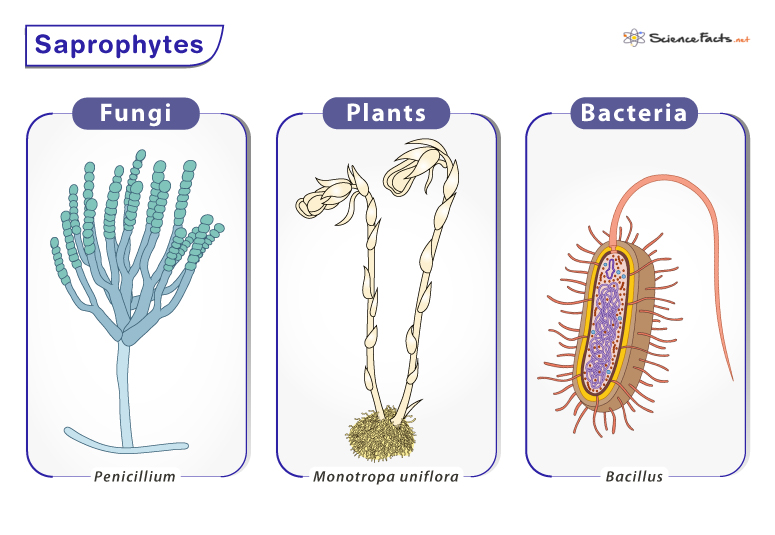Saprophytes
Saprophytes, or saprotrophs, are heterotrophic organisms that obtain their nutrients by breaking down dead or decaying organic matter. They play a crucial role in breaking complex organic compounds into simpler forms, a process known as decomposition, and thus are also called decomposers.
Examples of Saprophytes
Saprophytes can be found in various kingdoms of life. They include:
- Fungi, such as mushrooms, molds like Penicillium, and yeast
- Some plants, like orchids and Indian pipe (Monotropa uniflora)
- Certain bacteria, like those belonging to the genus Bacillus and Clostridium
Characteristics of Saprophytes
Saprophytes possess a range of adaptations that enable them to thrive in their specialized ecological niche.
- Have a range of adaptations that enable them to thrive in their specific environment
- Do not possess chlorophyll for photosynthesis and thus cannot prepare their food
- Absorb environmental nutrients through specialized structures, such as fungal hyphae or bacterial cell walls
- Specialize in breaking down dead organic matter with the help of enzymes and then absorbing the resulting breakdown products
- Produce spores and filaments
- Can thrive in diverse habitats, ranging from forests and grasslands to aquatic ecosystems, and can adapt to decaying organic matter, such as fallen leaves, dead animals, or decaying plant material.
Nutrition in Saprophytes
Saprophytes obtain their nutrients from the dead and decaying matter of plant and animals and their remains. They utilize unique nutritional strategies to derive nutrients from the environment, known as saprophytic nutrition. These are as follows:
- They secrete various enzymes that break down complex organic molecules into simpler compounds. These enzymes, such as proteases, carbohydrases, and lipases, act externally on the dead organic matter, catalyzing the breakdown of proteins, carbohydrates, and lipids.
- Once the enzymes have broken down the organic matter, saprophytes absorb the resulting breakdown products. For example, fungi have a network of thread-like structures called hyphae, which penetrate the decaying organic material. The hyphae secrete enzymes that degrade the organic matter externally, and the resulting soluble nutrients are absorbed through the hyphal walls.
Ecological Significance of Saprophytes
By decomposing dead organic matter, saprophytes release essential nutrients back into the ecosystem and thus play a key role in maintaining the balance and health of ecosystems. These nutrients, such as nitrogen, phosphorus, and carbon, become available to other living organisms, including plants, which become part of a fresh nutrient cycle.
Saprophytes also contribute to disease control by breaking down dead organisms, including those infected with pathogens. It prevents the spread of diseases and reduces the accumulation of potential disease-causing agents in the environment.
FAQs
Ans. No, vultures do not decompose dead and decaying matter and, thus, are not saprophytes.
Ans. Parasites are living organisms that feed on the host organisms for their survival. In contrast, saprophytes are living organisms that feed on dead and decaying matter.
Ans. A facultative saprophyte is an organism that usually obtains its nourishment from living matter. But sometimes, it can also obtain its nourishment from dead organic matter.
Ans. No, it is a parasite.
Ans. If a fungus forms haustoria, it is parasitic.
-
References
Article was last reviewed on Thursday, August 3, 2023




